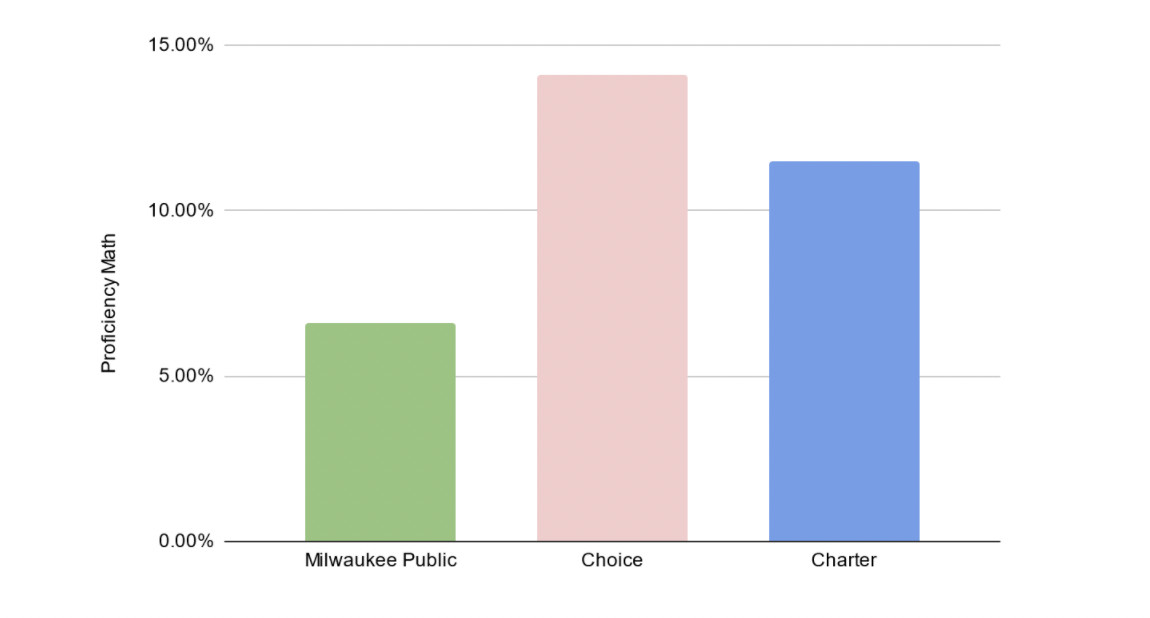Will Flanders, Research Director
Wisconsin’s recently released state report cards for the 2020-21 school year paint a relatively rosy picture: 399 (out of 422) districts “Met”, “Exceeded”, or “Greatly Exceeded” expectations according to the data. But these report cards seem to be whistling past the graveyard of deep problems with student achievement.
The Lake Wobegon Effect – Is Everyone Really Above Average?
Milwaukee Public Schools (MPS) are a great example of this problem. During the 2020-21 school year, reported proficiency rates on the Forward Exam were just 7.3% in English and 4.2% in mathematics. Even accounting for the huge percentage of students that didn’t take the exam, proficiency rates have fallen consistently over the past four years. English/Language Arts proficiency is depicted, but a similar pattern exists for other subjects.
 Despite this dismal performance, the MPS was rated as “Meets Expectations” on the state report card for a second consecutive year. While this pattern is the most extreme in Milwaukee, it exists in other districts as well. For instance, despite only two students out of 376 test takers reaching English proficiency at Menominee Indian, the district avoided the lowest grade on the report card. The district instead received two out of five stars—apparently one for each proficient kid.
Despite this dismal performance, the MPS was rated as “Meets Expectations” on the state report card for a second consecutive year. While this pattern is the most extreme in Milwaukee, it exists in other districts as well. For instance, despite only two students out of 376 test takers reaching English proficiency at Menominee Indian, the district avoided the lowest grade on the report card. The district instead received two out of five stars—apparently one for each proficient kid.
How does this happen? The main culprit is the outsized importance that student growth plays in report card scores in the state. Because many students from low-income backgrounds need help in “catching up” to their peers from wealthier backgrounds, the state report card gives schools and districts credit for student growth—movement towards proficiency without necessarily getting there. But WILL has regularly made the case that the current report card goes too far in this direction. In districts like Menominee Indian and Milwaukee, growth makes up 90% of the achievement portion of their score. Catching kids up absolutely matters, but the state report card should provide parents and schools with information about how students are actually performing in the classroom.
Post-pandemic, Wisconsin parents are empowered to better understand what their students are learning and how they are being taught. But the DPI report cards mask the reality that far too many students are not learning at grade level and may mislead parents that “everything is okay.”
Choice and Charter vs. Public
On a more encouraging note, the report cards reveal that Milwaukee’s public charter and private choice schools have, once again, proven themselves to produce a higher “bang for the buck.” Proficiency rates among students in choice schools were more than double, on average, the average proficiency rates in Milwaukee Public Schools. In my six years of analyzing this data, this is by far the largest proficiency gap that I have observed.

This may, in part, show the effects of keeping school doors closed for most of an entire school year. While some private choice schools and public charter schools remained shuttered as well, many worked hard to continue to educate students in-person.
A similar huge performance advantage is seen in Racine between choice and traditional public schools. Students in Racine’s private choice schools had a proficiency rate of approximately 22%, on average, compared to slightly less than 10% in public schools.

The stark gaps suggest kowtowing to the demands of the teacher’s union at the expense of kids will have a long-term cost. That said, it is worth noting that proficiency rates remain far too low across all three sectors; we must continue to work towards improvement in all of them.
Wisconsin’s report card isn’t meeting anyone’s expectations. Parents that rely on the report card for information about the quality of local schools are done a disservice when the information doesn’t paint a clear picture of whether students are learning. Providing more information and transparency about student proficiency is beneficial to parents and school leaders. We can craft a report card that captures growth while still insisting that achieving proficiency matters.